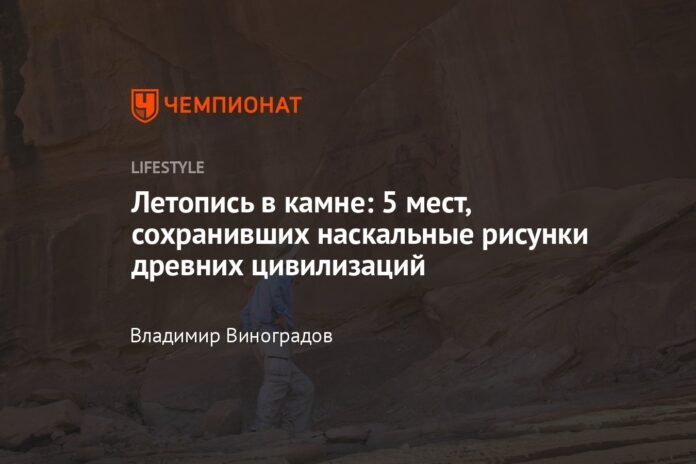President of Pro-Vision, author of the Vinogradov.story community
“Cave painting is considered one of the oldest forms of art. The earliest drawings, dating back to the Stone Age, are found in many parts of the world and often illustrate everyday scenes or cult themes. Tourist routes have been laid out around some petroglyphs and geoglyphs, while others were discovered only recently – by the standards of history, literally yesterday. I will tell you about the most interesting ones below.”
The link tells you where to go in autumn:
Video
Beautiful travel season: 5 ideas on where to go in autumn
Petroglyphs of Belomorsk and Lake Onega, Karelia
About 100 years ago, rock paintings were discovered in Karelia near the town of Belomorsk, which are believed to be between 4 and 5 thousand years old. The petroglyphs of the White Sea region are made using the engraving technique, covered with red ochre, and depict people, animals, ships, and hunting and fishing scenes. Some of them reach sizes of up to several meters in length.
But the most famous collection of Karelian images is located on the cape with the terrifying name of Besov Nos on Lake Onega. The cape owes its name to a petroglyph – a two-meter anthropomorphic “demon” discovered by Christian monks. However, the “demon” behaves peacefully and willingly allows not only scientific researchers, but also tourists to visit.
Petroglyphs at Cape Besov Nos
Photo: istockphoto.com/maxcam2008
Cave drawings in Sulawesi, Indonesia
To date, the oldest cave painting is a Celibate pig hunting panorama, found in one of the karst caves on the Indonesian island of Sulawesi. According to scientists, this drawing is no less than 43,900 years old! However, for this region, the venerable age of cave art is more of a rule than something exceptional. Only Australians, also dedicated to hunting, can compete with Indonesian drawings for the right to be called the oldest in the world. But the age is the same, more or less.
Sulawesi cave drawing
Photo: Maxime Aubert, griffith.edu.au
Cholpon-Ata Petroglyphs, Kyrgyzstan
Not far from Issyk-Kul lies one of the most mysterious and mysterious places in Kyrgyzstan – the Cholpon-Ata area. Locals call it the Stone Garden. Well, outside the country it is known by a less romantic, but much more intriguing name – the Cholpon-Ata petroglyphs. How and when thousands of rocks with mysterious carved patterns appeared on a vast territory of 4 hectares, no one can say for sure. Most likely, they were washed away by glaciers and mudflows from the gorges of the Kungoy-Ala-Too ridge, where the sites of ancient people were located.
This is also indicated by the themes of the rock paintings: these are mainly everyday hunting scenes and drawings of animals – deer, ibex and snow leopards. And in later petroglyphs, caravans of camels with drivers are clearly visible – an obvious sign of the Great Silk Road. Most of the boulders are oriented towards the south-east and south-west, and therefore scientists associate their origin with religious ceremonies. The unusual shapes of the stones also indicate their cult status: among the blocks there are cromlechs, tombstones and balbals – stone sculptures with portraits of ancestors. According to an alternative version, the Stone Garden is also a huge ancient observatory created to observe celestial bodies.
Realistic images in Chauvet, France.
Unlike Asian cave art, European cave art cannot boast of an exceptional history: the earliest images on the continent are only 25-30 thousand years old. But later European drawings are amazingly realistic. One of the most outstanding works of ancient fine art is “exhibited” in the Chauvet Cave in France: these are again images of animals, but no longer schematic, but completely figurative. A herd of horses, bulls and rhinoceroses – all of them are easy to recognize without reading the information signs. Moreover, looking at the Chauvet drawings, one gets the impression that the unknown artist did not just document everyday life, but deliberately honed his skills: horse heads, one of the classic images of painting, turned out to be better and better with each new attempt.
Cave paintings in the Chauvet cave
Photo: istockphoto.com/atlantic-kid
Rock paintings in Gobustan, Azerbaijan
From the drawings, of which there are at least 6,000 in Gobustan, it is easy to trace the “evolution” of rock art themes. It all starts with hunting and fishing scenes, then dancing people and circular dances appear, and later – tools (a sickle and a flat-bottomed boat) and calligraphy. At the same time, over time, the drawings become smaller, but more complex. They were knocked down with river pebbles on soft limestone, which was not a difficult task, but interesting. Perhaps that is why among the “serious” themes there are also ironic ones – for example, the “autographs” of ancient authors.
Petroglyphs in Gobustan
Photo: istockphoto.com / AlizadaStudios
Here we leave you a link to the most mystical places in our country:
Travelers’ Choice: 4 Mystical Places in Russia for Those Who Like to Tickle Their Nerves
Do you want to receive more tips and tricks for a healthy lifestyle?
Subscribe to the weekly Lifestyle newsletter.
Subscribe by email

